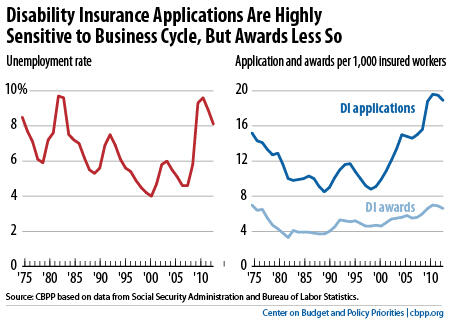off the charts
POLICY INSIGHT
BEYOND THE NUMBERS
BEYOND THE NUMBERS
Disability Benefits Are Hard to Get — Even in Recessions
Receive the latest news and reports from the Center
We’ve noted before that economic downturns generally spur more applications for Social Security disability benefits — but have a much smaller effect on awards. (See graph.) That usual pattern is based on several decades’ worth of recessions and expansions. And it seemed to be holding true in the Great Recession that officially began in late 2007.

Now the Social Security actuaries have confirmed what our earlier post implies: allowance rates tend to fall in economic downturns. That is, when the unemployment rate rises, the state and federal agencies that sift applications for disability benefits allow a smaller fraction of claims.
The actuaries found that the lag between rising unemployment and falling allowance rates is about two years — which makes sense, because workers typically exhaust other sources of support (including unemployment insurance) before applying, as a last resort, for disability benefits.
Another recent study found that in local areas where unemployment was higher, allowance rates were lower. That, too, supports the general theme: a sour economy boosts applications more than awards.
In short, the disability programs do a pretty good job of weeding out people who don’t meet the strict eligibility criteria. Standards don’t become more lax in recessions, and stories that focus only on the growth in applications omit that crucial fact.